Do Aliens Exist?


The question of whether aliens exist is one of the most profound and enduring mysteries of the universe. It captivates the human imagination and has sparked countless debates among scientists, philosophers, and the general public for centuries. To address this question comprehensively, we must consider scientific theories, empirical evidence, philosophical perspectives, and the implications of potential contact with extraterrestrial civilizations.
Scientific Perspectives
From a scientific standpoint, the existence of extraterrestrial life is considered plausible, given the vastness of the universe and the diversity of planetary systems. The Milky Way galaxy alone is estimated to contain billions of planets, many of which could potentially harbor conditions conducive to life as we know it. The discovery of exoplanets—planets orbiting stars outside our solar system—has expanded our understanding of planetary diversity and increased optimism about finding habitable worlds.
The search for extraterrestrial intelligence (SETI) involves scanning the cosmos for signals that could indicate the presence of advanced civilizations. Projects like the Allen Telescope Array and Breakthrough Listen initiative are dedicated to detecting radio signals or other forms of communication from distant star systems. While no definitive evidence of extraterrestrial intelligence has been found to date, ongoing advancements in technology and observational techniques continue to push the boundaries of our search capabilities.
Scientific Astrobiology and Habitability
Astrobiology is the interdisciplinary field that explores the origin, evolution, distribution, and future of life in the universe. It considers the conditions necessary for life to emerge and thrive, including liquid water, organic molecules, and energy sources. Earth serves as a model for habitable environments, but recent discoveries have expanded our concept of where life could exist.
Mars, for example, once had liquid water on its surface and may still harbor microbial life in its subsurface. Europa and Enceladus, moons of Jupiter and Saturn respectively, have subsurface oceans beneath icy crusts that could potentially support microbial life. Extremophiles—organisms capable of surviving in extreme conditions on Earth—suggest that life could adapt to environments once considered inhospitable, such as high radiation or extreme temperatures.
Scientific Philosophical Considerations
The question of extraterrestrial life raises profound philosophical questions about humanity’s place in the cosmos. The “Fermi Paradox,” for instance, asks why, given the vast number of potential civilizations, we have not yet detected any signs of extraterrestrial intelligence. Possible explanations range from the rarity of intelligent life and the challenges of interstellar communication to the possibility of civilizations avoiding detection or self-destructing before becoming spacefaring.
Ethical considerations also arise regarding potential contact with extraterrestrial civilizations. Issues of cultural exchange, environmental impact, and the implications for global society and religion are topics of ongoing debate and speculation.
Scientific Historical and Cultural Impact
Throughout history, humanity has been fascinated by the idea of beings from other worlds. Ancient myths, religious texts, and cultural narratives often incorporate stories of gods, angels, or otherworldly visitors. The modern era of UFO sightings and alleged alien abductions has added a contemporary layer to our fascination with extraterrestrial beings.
Popular culture, including science fiction literature, films, and television shows, has further shaped public perceptions of aliens and interstellar travel. Imaginative depictions range from benevolent extraterrestrial mentors to malevolent invaders, reflecting both our hopes and fears about encountering intelligent life beyond Earth.
The Search Continues
As scientific exploration and technological capabilities advance, the search for extraterrestrial life continues to evolve. Missions to Mars, Europa, and other celestial bodies will provide new insights into the potential for habitability and the presence of life beyond Earth. Advancements in telescopes, spectroscopy, and space-based observatories enhance our ability to detect exoplanets and analyze their atmospheres for biomarkers.
Ultimately, while we have yet to definitively answer the question of whether aliens exist, the pursuit of this question drives scientific inquiry, technological innovation, and philosophical reflection. Whether we discover microbial life on Mars, detect a distant radio signal, or someday make contact with an advanced civilization, the search for extraterrestrial life challenges us to expand our understanding of the universe and our place within it. It is a quest that continues to inspire wonder, curiosity, and a deeper appreciation for the vastness and complexity of cosmic existence.

Evidence and Scientific Exploration
While definitive proof of extraterrestrial life remains elusive, scientific exploration has uncovered tantalizing clues that suggest the potential for life beyond Earth. Here are some key pieces of evidence and lines of inquiry:
Exoplanets and Habitable Zones: The discovery of thousands of exoplanets—planets orbiting stars other than our Sun—has expanded our understanding of planetary diversity. The concept of the “habitable zone,” where conditions may be suitable for liquid water and potentially life as we know it, has broadened our search parameters. Planets like Kepler-186f, Proxima Centauri b, and TRAPPIST-1e are examples of exoplanets located within their star’s habitable zone.
Mars: Past and Present: Mars, our neighboring planet, has intrigued scientists with its history of liquid water and potential for microbial life. Evidence from missions like NASA’s Curiosity rover suggests that Mars had lakes, rivers, and a more Earth-like environment billions of years ago. Ongoing missions, including the Perseverance rover and upcoming sample return missions, aim to search for biosignatures and gather data that could shed light on the possibility of past or present life on Mars.
Extreme Environments on Earth: Earth hosts a variety of extremophiles—organisms capable of surviving in extreme conditions such as high temperatures, acidity, or salinity. These resilient life forms expand our understanding of where life can exist and thrive, suggesting that similar conditions on other planets or moons in our solar system could potentially support microbial life.
Search for Extraterrestrial Intelligence (SETI): SETI initiatives involve scanning the cosmos for signals that could indicate the presence of advanced civilizations. Projects like the Allen Telescope Array and Breakthrough Listen focus on detecting radio signals or other forms of communication from distant star systems. While no confirmed extraterrestrial signals have been detected, ongoing advancements in technology and data analysis continue to refine our search capabilities.
Theoretical Considerations
Several scientific theories and frameworks provide context for the search for extraterrestrial life:
Drake Equation: Proposed by astronomer Frank Drake, the Drake Equation estimates the number of active, communicative extraterrestrial civilizations in the Milky Way galaxy. It considers factors such as the rate of star formation, the number of planets per star with habitable conditions, and the fraction of planets where life evolves.
Fermi Paradox: Named after physicist Enrico Fermi, this paradox asks why, given the high probability of extraterrestrial civilizations in the universe, we have not yet detected any clear evidence of their existence. Proposed solutions range from the rarity of intelligent life to the challenges of interstellar travel and communication.
Rare Earth Hypothesis: This hypothesis posits that complex life, including intelligent civilizations capable of advanced technology and communication, may be rare in the universe. Factors such as the stability of planetary orbits, the presence of a large moon, and the role of plate tectonics and magnetic fields in maintaining a habitable environment on Earth are considered critical for the emergence and persistence of complex life.
Future Directions
As scientific exploration and technological capabilities advance, the search for extraterrestrial life continues to evolve. Future missions to Mars, Europa, Enceladus, and other celestial bodies will provide new opportunities to investigate habitability and search for signs of life beyond Earth. Advancements in telescopes, spectroscopy, and space-based observatories will enhance our ability to detect exoplanets and analyze their atmospheres for biomarkers.
In conclusion, while conclusive proof of extraterrestrial life remains elusive, the quest to answer the question “Are we alone?” drives scientific discovery, technological innovation, and philosophical reflection. Whether we discover microbial life on Mars, detect a distant radio signal, or someday make contact with an advanced civilization, the search for extraterrestrial life challenges us to expand our understanding of the universe and our place within it. It is a journey that inspires wonder, curiosity, and a deeper appreciation for the mysteries of cosmic existence.

Where They Are?
The question of where aliens might be, if they exist, is a complex and speculative one that involves considerations of the vastness of the universe, the challenges of interstellar travel, and the potential diversity of extraterrestrial civilizations. Here’s a detailed exploration of possible locations and scenarios where aliens could hypothetically exist:
Within our Solar System:
Mars: Mars has been a primary focus of astrobiological interest due to its past history of liquid water and the potential for microbial life. Ongoing missions like NASA’s Perseverance rover are searching for biosignatures that could indicate past or present life.
Europa and Enceladus: Moons of Jupiter and Saturn, respectively, have subsurface oceans beneath icy crusts. These environments could potentially harbor microbial life, sustained by hydrothermal vents and chemical energy sources.
Other Moons and Celestial Bodies: Moons such as Titan (Saturn’s moon with lakes of liquid methane and ethane), and Triton (Neptune’s moon with possible subsurface oceans) also pose intriguing possibilities for microbial life in our own solar system.
Exoplanetary Systems:
Habitable Exoplanets: Planets located within the habitable zone of their parent stars—where conditions might be suitable for liquid water and potentially life—could host extraterrestrial civilizations. Examples include Proxima Centauri b and TRAPPIST-1e.
Goldilocks Zone: This region around a star where conditions are just right for liquid water to exist on a planet’s surface is a prime target for the search for habitable exoplanets.
Technologically Advanced Civilizations:
Dyson Spheres: These hypothetical megastructures, proposed by physicist Freeman Dyson, could surround a star to harness its energy. Detection of irregularities in starlight could suggest the presence of such advanced civilizations.
Interstellar Migrations: Advanced civilizations might utilize technologies to migrate between star systems over vast distances and time scales, possibly utilizing methods like generation ships or advanced propulsion systems.
Cosmic Signatures:
Radio Signals: The search for extraterrestrial intelligence (SETI) involves scanning the cosmos for artificial radio signals or other electromagnetic emissions that could indicate communication from advanced civilizations.
Astroengineering Projects: Detectable signatures of megastructures or engineering projects (like massive energy production or manipulation of starlight) could provide indirect evidence of technologically advanced civilizations.
Unconventional Environments:
Extreme Environments: Extraterrestrial life might exist in environments previously considered inhospitable on Earth, such as high radiation zones, extreme temperatures, or high-pressure environments.
Subsurface Habitats: Microbial life could potentially thrive in subsurface oceans, beneath ice crusts, or within the deep subsurface of planets, moons, or asteroids.
Speculative Scenarios:
Exotic Forms of Life: Life forms that are fundamentally different from Earth-based life could exist, utilizing alternative biochemistries or energy sources.
Cryptic or Hidden Civilizations: Advanced civilizations might intentionally remain hidden or use technologies beyond our current understanding to evade detection.

Do We Have Proof They Exist?
Knowing if a phenomena or entities exist often hinges on the availability and reliability of evidence. For instance, when discussing extraterrestrial life or advanced technologies, we rely on scientific observations, experiments, and empirical data to establish proof.
In many cases, while there may be compelling indirect evidence or strong theoretical frameworks suggesting their existence, definitive proof may still be elusive. For example, the search for extraterrestrial intelligence involves detecting signals or finding biosignatures, but conclusive evidence of alien life has not yet been confirmed.
Similarly, the study of dark matter and dark energy provides evidence of their effects on the universe, but direct proof of their existence remains a challenge. Ultimately, the existence of such phenomena is often supported by a combination of indirect evidence and theoretical models, and the quest for direct proof continues to drive scientific inquiry and exploration.
Scientific and Skeptical Perspectives
Despite these intriguing phenomena and claims, the scientific community generally maintains a skeptical stance due to the lack of conclusive evidence. The search for extraterrestrial life continues through rigorous scientific methods, including the study of exoplanets, astrobiology, and SETI initiatives. Scientists prioritize evidence-based approaches and peer-reviewed research to evaluate potential signs of life beyond Earth.
While there are numerous anecdotes, sightings, and cultural references that suggest the possibility of extraterrestrial beings, definitive proof remains elusive. Scientific exploration and technological advancements are essential in advancing our understanding of the universe and the potential for life beyond Earth. The search for extraterrestrial life challenges us to remain curious, open-minded, and grounded in evidence as we continue to explore the mysteries of the cosmos.

What would alien life actually look like?
Understanding what alien life might look like is a speculative yet fascinating topic that combines scientific inquiry with creative imagination. While we have yet to discover definitive evidence of extraterrestrial life, scientists use principles of biology, chemistry, and planetary science to hypothesize about the forms and characteristics that alien organisms might exhibit. Here’s an exploration of what alien life could potentially look like:
Potential Forms and Features
The potential forms and features of extraterrestrial life, often referred to in the context of “aliens,” are as diverse as the imaginations of scientists and science fiction creators. Theoretically, extraterrestrial beings could range from microbial life forms to highly advanced civilizations. In terms of biological forms, aliens might possess entirely unfamiliar anatomy and physiology, adapted to environments vastly different from Earth. For instance, they could thrive in extreme conditions such as high radiation, extreme temperatures, or high-pressure environments, leading to unique physical adaptations. Intelligence levels could vary widely, from simple organisms with basic survival instincts to complex entities with advanced technology and communication methods. Communication might involve methods beyond human understanding, such as electromagnetic signals, biochemical processes, or even quantum states. Sensory perceptions could be tailored to their environment, potentially using senses we do not possess, like detecting electromagnetic fields or chemical gradients. Additionally, extraterrestrial life could exhibit forms of social organization and behavior that are completely alien to us, from solitary beings to highly cooperative, collective entities. The technological capabilities of advanced extraterrestrial civilizations might include propulsion systems allowing interstellar travel, sophisticated energy sources, and advanced computational systems. Exploring these potential forms and features not only broadens our understanding of the universe but also challenges our assumptions about life and intelligence.
Alien Adaptations and Environments
Alien adaptations and environments encompass a wide range of possibilities, reflecting the diverse conditions that extraterrestrial life might encounter across the universe. Adaptations could vary significantly based on the environmental challenges faced by extraterrestrial organisms. For instance, in extreme cold environments, such as those on icy moons or distant planets, life forms might develop antifreeze proteins or slow metabolic rates to survive. Conversely, in high-temperature environments, such as those found near stars or volcanic worlds, aliens might evolve heat-resistant proteins or insulating exoskeletons.
In high-pressure environments, like those found deep within gas giants or underwater worlds, extraterrestrial life might have flexible, robust structures to withstand immense forces. On the other hand, in low-gravity environments, life forms might exhibit elongated or lightweight structures to adapt to the reduced gravitational pull. Radiation-intensive environments, such as those with high cosmic radiation or near powerful stellar radiation, could lead to adaptations like enhanced DNA repair mechanisms or protective shielding.
Metabolic processes could also vary, with life potentially relying on alternative biochemical pathways, such as chemosynthesis instead of photosynthesis, using chemicals available in their environment, like hydrogen sulfide or ammonia, to produce energy. In terms of sensory adaptations, extraterrestrial beings might have evolved senses beyond human capabilities, such as the ability to detect electromagnetic fields or perceive a broader spectrum of wavelengths.
The environments themselves could be as varied as the adaptations they drive. Life might exist in liquid methane seas on Titan, or within the subterranean oceans of Europa, where life forms could be adapted to icy, dark conditions. Alternatively, in hostile atmospheres rich in toxic gases or extreme weather patterns, organisms might possess protective features or sophisticated systems to manage and mitigate environmental hazards.
Detecting and Studying Alien Life
Detecting and studying alien life involves a blend of advanced techniques and technologies to search for signs of life beyond Earth. Astronomers use telescopes and space observatories to identify potentially habitable exoplanets by examining their atmospheres for biosignatures such as oxygen and methane. Remote sensing missions with rovers and landers analyze planetary surfaces and atmospheres for organic compounds and other markers of life. Astrobiologists simulate extreme environments on Earth to understand how life might exist elsewhere, refining criteria for habitability. The Search for Extraterrestrial Intelligence (SETI) employs radio telescopes to listen for structured signals that could indicate advanced civilizations. Additionally, planetary protection protocols ensure that spacecraft do not contaminate other worlds with Earth-based microbes, which could skew results. Future missions may include sample return operations, bringing back extraterrestrial materials for in-depth analysis. Despite the challenges posed by vast distances and extreme conditions, these methods collectively advance our search for and understanding of potential alien life.
Speculating about what alien life might look like engages both scientific curiosity and imaginative exploration. While we have yet to confirm the existence of extraterrestrial life, ongoing scientific research, technological advancements, and the discovery of exoplanets continue to fuel optimism that we may one day encounter life forms beyond Earth.
As our understanding of astrobiology and planetary science evolves, so too will our ability to recognize and comprehend the diversity of life in the universe, offering new insights into the nature of life itself and our place in the cosmos



Post Comment